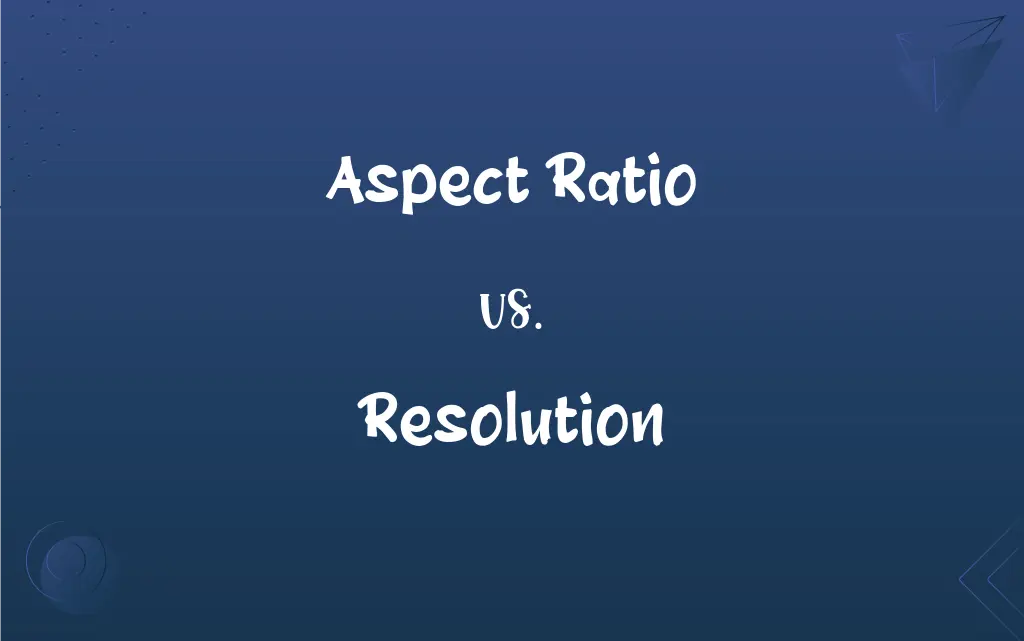Aspect Ratio vs. Resolution: What's the Difference?
Edited by Aimie Carlson || By Janet White || Published on January 30, 2024
Aspect ratio is the proportional relationship between width and height of an image, while resolution is the number of pixels in the width and height of an image.

Key Differences
Aspect ratio describes the proportional dimensions of an image or screen, typically represented as two numbers separated by a colon, such as 16:9. Resolution refers to the total number of pixels displayed on a screen, expressed as width x height, like 1920x1080.
The aspect ratio determines the shape of the display or image, whether it's more rectangular (like 16:9) or square (like 4:3). Resolution, on the other hand, determines the clarity and detail of the image, with higher resolutions offering more detail.
Changing the aspect ratio of a display or image can affect how content fits or appears, possibly leading to stretching or black bars. Altering the resolution can impact the quality and size of the image, influencing how sharp or clear the picture is.
Aspect ratios are crucial in various media formats, ensuring that movies or photos retain their intended shape across different screens. Resolutions are essential in defining image quality in digital photography, gaming, and video streaming.
Aspect ratio remains constant regardless of screen size, maintaining the same shape on a small phone or a large TV. Resolution can vary across devices; a larger screen may have a higher resolution to maintain image quality.
ADVERTISEMENT
Comparison Chart
Definition
Proportional relationship between width and height
Number of pixels in width and height
Expressed As
Ratio (e.g., 16:9, 4:3)
Pixel dimensions (e.g., 1920x1080)
Primary Influence
Shape and layout of the image or screen
Clarity and detail of the image
Change Impact
Affects how content fits and appears
Affects image quality and size
Importance in Media
Ensures consistent viewing experience across devices
Determines image sharpness and detail
ADVERTISEMENT
Aspect Ratio and Resolution Definitions
Aspect Ratio
The ratio of width to height in a screen or image.
Most modern TVs have an aspect ratio of 16:9.
Resolution
Resolution is critical in defining digital image quality.
Streaming services offer films in various resolutions, including HD and 4K.
Aspect Ratio
Aspect ratio determines how content is framed and viewed.
Films shot in a 2.35:1 aspect ratio often appear more cinematic.
Resolution
The number of horizontal and vertical pixels in a display.
A 4K TV resolution is 3840x2160 pixels.
Aspect Ratio
Aspect ratio is key in maintaining the intended visual presentation.
Changing the aspect ratio can distort a photograph's original composition.
Resolution
Higher resolution means more image detail and sharpness.
Photographers prefer high-resolution cameras for clearer pictures.
Aspect Ratio
Aspect ratio affects the overall aesthetics of visual content.
Social media platforms often use a 1:1 aspect ratio for profile pictures.
Resolution
Resolution is a key factor in print quality.
Printing a photo in high resolution ensures a crisp and clear output.
Aspect Ratio
Different aspect ratios cater to various viewing preferences.
Some people prefer the 4:3 aspect ratio for classic television shows.
Resolution
Resolution affects the clarity and realism of video games.
Gamers seek high-resolution monitors for a more immersive experience.
Resolution
The state or quality of being resolute; firm determination
Faced the situation with resolution.
Resolution
A firm decision to do something
Made a resolution to get more exercise.
FAQs
Why is aspect ratio important in TVs?
It ensures that content is displayed correctly without distortion.
Can aspect ratio be changed?
Yes, but it may result in stretching or black bars in images or videos.
Can two devices with the same aspect ratio have different resolutions?
Yes, resolution can vary even if the aspect ratio is the same.
What is resolution in simple terms?
The total number of pixels in an image, determining its clarity and detail.
How does resolution affect a smartphone's display?
Higher resolution leads to sharper and clearer images on the phone.
What's a good resolution for gaming?
Many gamers prefer at least 1080p, but 4K provides even greater detail.
What does aspect ratio mean?
It's the proportional relationship between the width and height of an image or screen.
Does a higher resolution always mean better quality?
Generally, yes, but it also depends on the screen size and viewing distance.
Is aspect ratio important in photography?
Yes, it determines how the photo is framed and displayed.
How do filmmakers decide on aspect ratio?
It's often based on the visual style and storytelling needs of the film.
Can the same content look different on various aspect ratios?
Yes, depending on the aspect ratio, content can appear stretched, compressed, or letterboxed.
What resolution is considered HD?
1280x720 pixels is standard HD, while 1920x1080 pixels is Full HD.
Does aspect ratio affect how we perceive visual content?
Yes, it influences how content is framed and viewed, impacting the overall experience.
Is 4K resolution four times better than 1080p?
4K has four times the pixels of 1080p, offering much finer detail.
Does changing aspect ratio affect resolution?
Changing aspect ratio alone doesn't change resolution but may alter how pixels are displayed.
What are common aspect ratios for films?
Common ratios include 16:9 for modern films and 4:3 for older films.
What aspect ratio is best for YouTube videos?
16:9 is the standard as it's fully compatible with YouTube's player.
Is a higher resolution always necessary for larger screens?
For larger screens, higher resolutions are preferred to maintain image clarity.
Is it better to have a higher resolution or the correct aspect ratio?
Both are important; the correct aspect ratio ensures proper display, while higher resolution improves clarity.
Can resolution be increased without losing quality?
Increasing resolution usually requires higher-quality source material; otherwise, quality may suffer.
About Author
Written by
Janet WhiteJanet White has been an esteemed writer and blogger for Difference Wiki. Holding a Master's degree in Science and Medical Journalism from the prestigious Boston University, she has consistently demonstrated her expertise and passion for her field. When she's not immersed in her work, Janet relishes her time exercising, delving into a good book, and cherishing moments with friends and family.
Edited by
Aimie CarlsonAimie Carlson, holding a master's degree in English literature, is a fervent English language enthusiast. She lends her writing talents to Difference Wiki, a prominent website that specializes in comparisons, offering readers insightful analyses that both captivate and inform.







































































